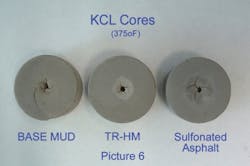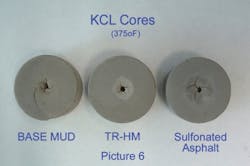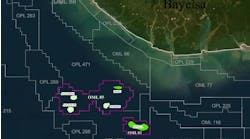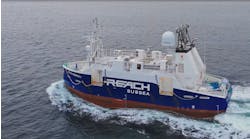On Sept. 22, theFPSO Cidade Angra dos Reis arrived on location in the Tupi area of Santos basin. Soon Petrobras expects to begin production at its FPSO in the pre-salt layer of the Santos basin. This is the first production platform of commercial scale scheduled for the Tupi region, and its startup is a major step forward in the company’s plans to develop the massive accumulations discovered in recent years under the layer of salt, said José Formigli, Petrobras’ executive-manager of the pre-salt areas.
TheFPSO Cidade de Angra dos Reis, chartered from Modec, is setting anchor in 2,149 m (705 ft) of water. It will connect immediately to well 9-RJS-660 and will begin producing between 15,000 to 20,000 b/d. The new platform has the capacity to produce up to 100,000 b/d and to process up to 5 MMcm/d (176.6 MMcf/d) of gas. Once peak production is reached, it will be connected to six oil producing wells, a gas injector, a water injector, and finally, one capable of alternating between water and gas injection.
As theCidade de Angra dos Reis arrives, the FPSO Cidade de São Vicente, which was conducting an extended well test (EWT) at Tupi on well 3-RJS-646, will transfer to the Northeast Tupi region, where it will begin a new EWT. Just like the Cidade de São Vicente, the Cidade de Angra dos Reis will continue, to collect technical data about the reservoir until December. From the designation of Tupi as a commercial area, currently expected by year-end, Cidade de Angra dos Reis will begin the Tupi Pilot Project phase, and also will be connected to well 3-RJS-646. It will complement the objective of the EWT by providing valuable information about the reservoir and production, considered essential for the conception of other pre-salt production units. This data will be fundamental for other pre-salt areas, especially to optimize the number of wells for each project, and to better define their geometry and type of stimulation required. The data also allows better performance evaluation of the different methods of recovery; inform calibration of oil flow tests in subsea lines; verify the performance of the subsea systems; and maximize the operational efficiency of the gas processing plant on the platform.
The Tupi Pilot will test the performance of the various recovery methods planned for the pre-salt layer, especially water alternating gas injection (WAG). The gas processing plant will treat the oil to separate the natural gas, the CO2, and the water, which can all be reused to improve the recovery of oil from the reservoir, by means of reinjection after sulfate extraction, as well as the possible re-injection of natural gas and CO2, or just CO2.
The commercial gas flow will be carried by an 18-in. (45 cm) pipeline that will connect the Pilot’s FPSO to a pipeline end manifold (PLEM) to be installed close to the platform in Mexilhão, which is a field of non-associated gas in Santos basin. At this point it will go to the coast, together with gas from Mexilhão and other areas, through an existing 34-in. (86 cm) pipeline, ending at the Monteiro Lobato gas treatment unit. This facility is being built by Petrobras in the city of Caraguatatuba, on the coast of São Paulo state. There it will be treated before going to the consumer market. The oil will be transported by relief vessels from theFPSO Cidade de Angra dos Reis.
The Tupi pilot system is expected to produce 100,000 b/d of pre-salt light oil. The first platform is in place and marks the beginning of pre-salt commercial production in Santos basin. Tupi has reserves of 5 to 8 Bbbl. Courtesy Petrobras.
At present, six wells have been drilled in the Tupi region. By 2017, Petrobras expects to put 11 production units into operation at the pre-salt cluster of the Santos basin, including three production pilots in the accumulations at Tupi, Northeast Tupi, and Guará; and another eight in locations still to be defined.
Santos basin development
The development of pre-salt production from Santos basin is quite different from projects carried out in the Campos basin in prior decades. This is not only because of the exploratory aspects, but also because of the expectation of high volumes of oil and gas spread over an extensive area.
The characteristics of the Santos basin pre-salt cluster make integrated development not only viable, but advantageous. The exploratory blocks are geographically close to one another in an area of about 11,600 sq km (4,478 sq mi) and were acquired simultaneously in leasing rounds promoted by the National Oil, Natural Gas, and Biofuels Agency (ANP) in 2000 and 2001. The exploratory risk in this area is shown be lower than that generally found in the industry. Every exploratory well drilled in the Santo basin pre-salt cluster so far has resulted in a discovery.
This combination of factors will make it possible for Petrobras and its partners (BG, Partex, Shell, Petrogal-Galp, Repsol) to develop the discoveries by creating solutions that can be deployed in several areas of the pre-salt pole. This will optimize the strategies for developing technologies, as will the contracting and use of physical and financial resources.
With this in mind, most all areas of Petrobras have worked together on the elaboration of the Master Plan for the Integrated Development of the Santos Basin Pre-Salt Cluster, better known as PLANSAL. The plan encompasses strategies and projects targeted over the next 20 years to develop the area. It consists of five project subprograms: exploratory evaluation; production development; logistical and flowline infrastructure; transportation and use of oil; and transformation and trading of gas.
These subprograms are supported by these functional plans: technological development; availability of critical resources; availability of skills; quality, health, safety, and the environment (QHSE); operational partnership management; regulatory aspects; investment optimization; and finally, integrated planning.
PLANSAL is not static or definitive. It is revised yearly to include data about the geology of the area, productivity of the reservoirs, subsea flow lines, and the performance of production facilities. This is why Petrobras emphasizes the strategy of extended well tests before defining the production systems. Acquiring the most data possible permits the company to perfect its concepts for these projects, reduce uncertainties and make planning increasingly effective.
Staged development
The subprograms for exploratory evaluation and production development will be in two stages, Phase 0 and Phase 1A. Phase 0, the data acquisition stage, began in 2008 and should end in 2016. It seeks to define the limits of the discoveries with an eye toward improving the geological characterization of the areas, as called for in the evaluation plans established by the ANP. Besides new surveys and seismic reprocessing, up to 37 delineation wells will be drilled and up to 18 EWTs will be performed. The Tupi Pilot will be conducted in this stage.
Iinformation from Phase 0 will be fundamental to define Phase 1, the definitive development stage. This phase is subdivided into 1A and 1B. Phase 1A, planned for sometime between 2013 and 2016, aims to exceed oil production of 1 MMb/d in locations operated by Petrobras, to generate cash flow for the development of Phase 1B, which is scheduled for 2017.
During Phase 1A, Petrobras will apply production concepts already mastered and adapted for pre-salt conditions. This phase will function as a field laboratory for development of new technologies. The two anticipated production pilots will be installed at this time at Guará and Northeast Tupi, both able to produce up to 120,000 b/d, as well as eight other production units, called “replicas,” to be done in series. The replicas, with hulls to be built in Brazil at the Rio Grande shipyard, each will have the capacity to produce up to 150,000 b/d. The natural gas processing capacity will be about 5 MMcm/d (176 MM cu ft/d). Each system will be connected to about 20 different wells, including producer and injector wells, as well as to subsea installations for production and flow control.
Phase 1B seeks to complete the development of the pre-salt cluster with the heavy use of new technologies. New technologies are expected to include production units with dedicated drilling rigs; dry christmas tree completion systems; alternate water and gas and/or CO2 injection for enhanced recovery; and new flow assurance solutions.
Transportation by ship will rely on systems that permit the transfer from relief vessels using dynamic positioning to conventional vessels for transport of the oil to the final destination. This option will be sufficient for the entire production volume foreseen in Phase 1A and part of 1B. The remainder could be transported by pipelines that will complement the outflow capacity for Phase 1B.
Due to its good characteristics – including low sulfur content and the production of derivatives with a high aggregate value – Brazilian pre-salt oil could reduce the volume medium to light crude imported into Brazil.
Initially, the gas will be transported via a subsea pipeline, which will connect Tupi to the gas pipeline network at Caraguatatuba. Later, plans are to install a new transport route, which could be either a floating liquefied natural gas (FLNG) plant or a new gas pipeline to the Cabiúnas Terminal in the Campos basin. Operational support will be handled by the subprogram for logistical infrastructure, whose basic strategy is to optimize support costs. It will be necessary to build ports, airports, fiberoptic rings, midway stations for the movement of fluids, and possibly an intermediate logistical support platform, says Petrobras.
Programs and initiatives
Petrobras relies on several initiatives and programs to reach its goals and objectives. An example is the program to develop CO2 technologies (PRO-CO2), which seeks to make it possible to capture, transport, and store carbon dioxide underground. Since both environmental preservation and operational safety are priorities, this program is being developed to reduce the emission of CO2 produced with pre-salt gas.
A new model of operations called GIOp – Integrated Operations Management – will be used in the Santos basin. It will focus on remote, integrated monitoring of operations.
The technology program for the development of pre-salt reservoirs (PROSAL) was created to maximize recovery of hydrocarbons from the area; identify the best well geometry for the reservoirs; and guarantee that the fluids produced flow without problems from the producing reservoirs to the production units.
With implantation of the Santos basin pre-salt cluster projects, there will be a significant increase in demand for goods and services in Brazil, say analysts. This will generate opportunities for the growth of domestic industries, whether through expansion of the existing industrial park or by creation of new players in the service and manufacturing sector.
One PLANSAL strategy will make possible a policy of domestic content in the construction in series of production units: the so-called “FPSO Factory.” This unprecedented initiative aims for swifter delivery of the units, thereby making it possible to anticipate the production curve and the economic return from the investments in the pre-salt cluster.
One challenge of the pre-salt layer in this area is the number of wells to be drilled. Considering that on average each production unit in Phases 0 and 1A could connect up to 20 wells, there will be around 200 wells drilled in the coming years. With this in mind, and in light of the overall demand generated by Petrobras’ exploratory efforts and by the development of its portfolio of production opportunities, the company has contracted a number of rigs to operate in ultra-deepwater. Currently, it is in the process of contracting up to 28 more units, all to be built in Brazil, in line with the strategy to have all the equipment available within the stipulated timeframe.
Both the FPSO Factory concept and the acquisition of rigs are part of a set of strategies to raise the index of local content to promote the expansion of the Brazilian industry in terms of global competition.
The demand for goods and services for the pre-salt projects is expected to create thousands of new jobs; improve the qualifications of the existing labor force; and increase income for a range of markets throughout Brazil. In this context, it is becoming increasingly clear that the Oil and Gas Mobilization Program (PROMINP) is making a major contribution toward maximizing the participation of local industry along competitive and sustainable lines. Petrobras also has created the Pre-Salt Skills Development Program (PRODESAL) to disseminate and perpetuate the knowledge and skills acquired to develop pre-salt areas.
Santos basin expansion
With the pre-salt cluster, Petrobras’ activities near the Santos basin will accelerate in the coming years. To support growth of company activities in the region, it recently purchased a 25,000 sq m (269,097 sq ft) area in the historical neighborhood of Valongo, in the city of Santos. The company plans to construct three high-rise buildings, with offices to coordinate basin operations. The installations will accommodate 6,000 people. With this project, together with others in the region, the neighborhood will go through a profound process of revitalization. It will be the first building in the city with green certification, as it foresees in its project the intelligent use of natural resources.
This undertaking illustrates a success story that began during the early part of the 2000s, when Petrobras decided to expand its exploratory activities beyond the central nucleus of the Campos basin, intensifying surveys to the north and south of the area, and advancing through the Santos and Espírito Santo basins, according to Petrobras officials.
For logistical support, there are four air support areas for the Santos basin operations: Jacarepaguá and Cabo Frio, Rio de Janeiro; Itanhaém, São Paulo; and Navegantes, in Santa Catarina. For sea support the port of Rio de Janeiro and the port of Imbetiba/Macaé, in Rio de Janeiro state; and the port of Itajaí, in Santa Catarina are used. In addition, two logistical bases with port and airport infrastructure are being considered for in Itaguaí, in Rio de Janeiro, and in part of the Santos air base, in Guarujá, in São Paulo.
Other pre-salt discoveries
Royal Dutch Shell has informed the Brazilian National Petroleum Agency that a pre-salt oil discovery has been made in Santos basin block BM-S-54. Shell said further analyses are necessary before announcing more details. Shell was awarded the concession in ANP’s Bidding Round 7 in 2005. As reported to ANP, the well hit a drilling depth of 5,800 m (over 19,000 ft).
Drilling activities are being performed byStena DrillMax since August. Total’s purchase of a 20% stake in BM-S-54 from Shell is pending approval from ANP. Shell has announced the sale of some of its assets in Brazil in order to restructure its portfolio and raise capital for priority projects. Shell says it plans to sell stakes in blocks BM-S-8 and the BM-S-45 in the Santos basin, in the BM-ES-23 block in Espirito Santo basin, and a 40% stake in the Oliva and Atlanta oil discoveries also in Santos basin.
Enter Sinopec
Chinese Sinopec acquired 40% of Spanish Repsol’s subsidiary in Brazil for $7.1 billion. This is the largest acquisition in the Brazilian oil sector and the second-largest overseas purchase by a Chinese oil company. Repsol Brazil also holds stakes in pre-salt fields. Repsol was previously planning an initial public offering to raise capital but decided to cancel it after considering Sinopec’s offer.China already has invested as much as $10 billion in the Brazilian oil industry and is the most likely entity to acquire assets from OGX. Repsol Brazil holds stakes in 22 exploration blocks and in the Albacora leste field operated by Petrobras. It has also announced seven oil discoveries so far and its oil reserves hold an estimated 1.7 Bbbl.
Rio Oil & Gas Expo
The eyes of the global oil industry were on Rio de Janeiro as it hosted the biennial Rio Oil & Gas Expo, the biggest event of its kind in Latin America. The event was held Sept. 13-16, 2010, at the city’s Riocentro convention center in Barra da Tijuca.
Held every two years since 1982, Rio Oil & Gas Expo and Conference is an international platform for the oil industry to promote new goods and services, exchange ideas, and discuss technological innovations.
Sustainability was a theme of this year’s discussions, and for the first time in the event’s history, a Social and Environmental Responsibility panel discussed the current issues, with a focus on the Globally Responsible Leadership Initiative, whose methodology adopted by 65 partner organizations including Petrobras, aims at cultural change in the decision-making processes of companies.
Another hot topic in the oil industry is Brazil’s pre-salt oil, lying under a thick layer of salt over 5 km (3 mi) below the surface of the ocean. Many companies that have developed new technologies for pre-salt development were present at the expo to demonstrate their innovations.
With a total of 23 participating countries, more than 1,200 exhibitors and nearly 40,000 participants, the Rio Oil & Gas Expo hosted was an important meeting point and exchange for those interested in the development of Brazil’s oil and gas resources.
The author
Peter Howard Wertheim is Offshore’s contributing editor based in Rio de Janeiro. He can be reached at[email protected].
Peter Howard Wertheim
Contributing Editor
Brazil will add the most oil production of any country outside OPEC over the next 25 years, and will surpass Venezuela and Mexico to become the second-largest producer in the Americas, according to the US EIA’sInternational Energy Outlook.
Offshore Articles Archives
View Oil and Gas Articles on PennEnergy.com





